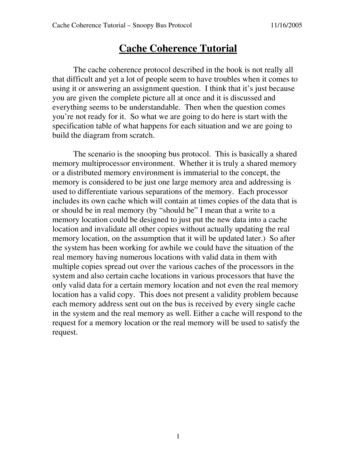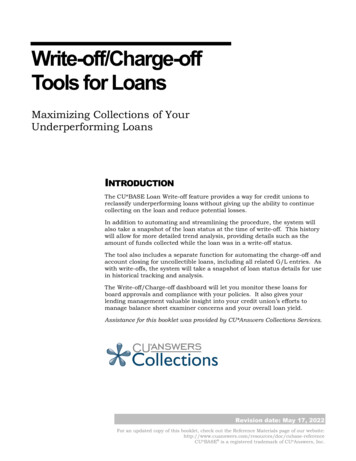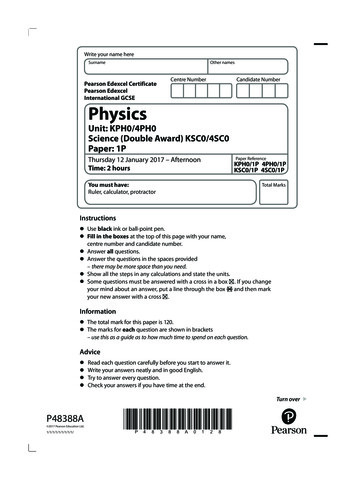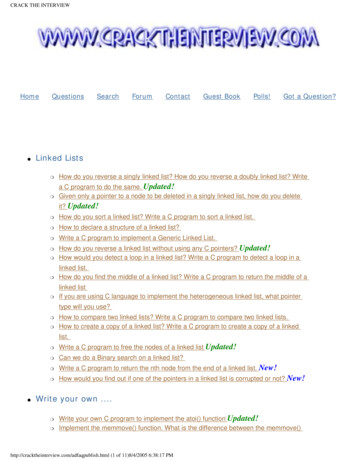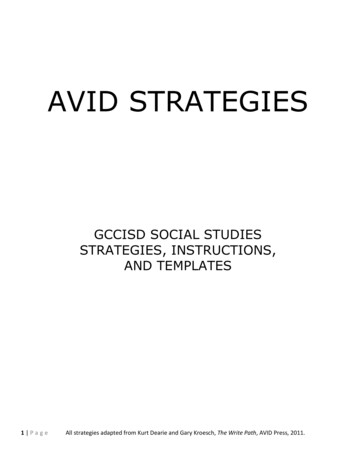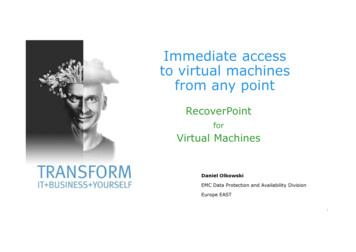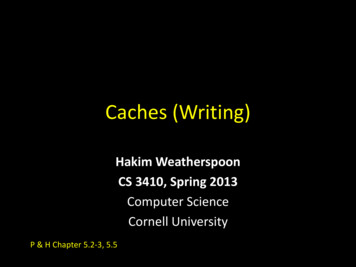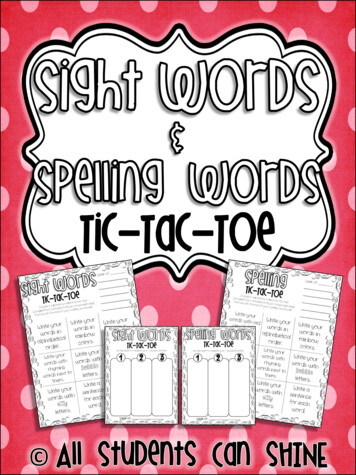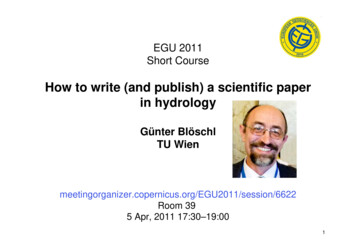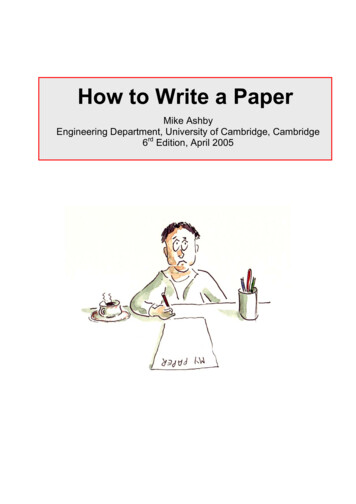
Transcription
How to Write a PaperMike AshbyEngineering Department, University of Cambridge, Cambridge6rd Edition, April 2005
Mike AshbyHow to Write a Paper6th Edition, February 2005IntroductionThis brief manual gives guidance in writing a paper about yourresearch. Most of the advice applies equally to your thesis or towriting a research proposal. The content of the paper reflects thekind of work you have done: experimental, theoretical,computational. I have used, as a model, a typical Materials project:one combining experiment with modeling and computation toexplain some aspect of material behaviour.Sections 1 to 8 give guidelines for clear writing with briefexamples. The Appendix contains longer examples of effectiveand ineffective writing. The manual is prescriptive—it has to be, if itis to be short. It is designed to help those struggling with their firstpaper, or those who have written several but find it difficult. Certainsections may seem to you to be elementary; they are therebecause, to others, they are not. Section 8, on Style, is openended, the starting point for more exciting things.How to write a paper, 6th edition1MFA, 20/02/05
Contents1 The Design p 32 The Market—Who are your readers? p 43 The Concept—Making a Concept-sheet p 54 Embodiment—The first draft p 95 Detail I—Grammar p 166 Detail II—Spelling p 207 Detail III—Punctuation p 218 Detail IV—Style p 269 Further Reading p 34Appendix p 37How to write a paper, 6th edition2MFA, 20/02/05
1 THE DESIGNWell-written papers are read, remembered, cited. Poorly writtenpapers are not.To write well, you need a design. Like any design activity, thereare a number of steps (Figure 1). I’ve used the language ofengineering design here—it fits well.The Market Need. What is the purpose of the document? Whowill read it? How will the reader use it? The answers help youdecide the length, the level of detail, the style.The Concept. Good writing starts with a plan. Writers havedifferent ways of developing plans. I find the concept-sheet(Section 3, below) is a good way to do it.Figure 1. The Design Process. Designing a paper is like designinganything else: there are five essential steps.The Embodiment. The embodiment is the first draft. Get the factsdown on paper without worrying about style; make drafts of eachsection; develop the calculations; sketch the figures; assembleHow to write a paper, 6th edition3MFA, 20/02/05
references.Detail. Now comes the crafting: clarity, balance, readability; in aword —style.The End-Product. Appearance is important: good layout, clearheadings, well-designed figures.The Sections that follow expand on each of these in turn.2 THE MARKET—Who are your readers?Your market is your readers. Put yourself in their shoes: what, ifyou were they, would you wish to find?The readers of your thesis are your examiners. They expectdetails of all relevant parts of your research: why you did it, itsbackground, your thinking, what you did, your conclusions andyour views on where it is going. They don’t want the irrelevantparts—details of how standard equipment works, for instance. Findout as much as you can about content and format from yoursupervisor and other students, and look at some recent(successful) theses to get a feel for the product this marketexpects.A paper is read by one or more skilled referees, and, if accepted,by a scientifically-informed audience. This manual focuses onwriting papers. The pages that follow explain how this marketshould be addressed.A research proposal usually addresses two markets. One is thefunding agency: the EPSRC, the EU, another GovernmentAgencies, or a Charity. They will look for a match between theirpriorities and yours. The other is the referees that the fundingagency will use; they are charged with judging quality, promiseHow to write a paper, 6th edition4MFA, 20/02/05
and relevance.Hardest to write is a popular article, addressing an audience whois intelligent—one should always assume that—but who mayknow nothing of your subject. Here style, always important, mustbe fine-tuned to meet their needs. More on style in Section 8.Make no mistake. Write poorly and you’ll bore, exasperate andultimately lose your readers. Write well, and they’ll respond in theway you plan.Figure 2. Markets for technical writing.3 CONCEPT—Making a Concept-SheetWhen you can’t write, it is because you don’t know what you wantto say. The first job is to structure your thinking. Settle downcomfortably with a cup of coffee (or better, beer) and an A3 sheetHow to write a paper, 6th edition5MFA, 20/02/05
of paper in Landscape orientation as in Figure 3. Devise atentative title for the paper and write it at the top. Then—in asorderly way as you can, but disorder is OK too—jot down whatseem like sensible section headings, each in its own box. Sketchin anything that occurs to you that belongs in a section—paragraph headings, figures, ideas. Think of things that might berelevant to the section—a reference, a graph you might need, anidea that requires further development. Put each in a bubble nearthe box to which it applies, with an arrow showing where it fits in.This is the time to de-focus, forget the detail and think bothlongitudinally and laterally.A3 or A4 sheet,landscape modeGood ideasfor the textBoxes withmain headingsThings that arestill neededLinks betweensections of textFigure 3. A model for a concept sheet.How to write a paper, 6th edition6MFA, 20/02/05
What should be in the paper? What else might be relevant? Whatelse might you need to do the job—a copy of X, a figure of Y, thereference Z? Put it all down. You realise that you need an extrasection—squeeze it in. You see that the order of sections is notgood—add arrows indicating the new order.All this sounds like a child’s game, but it is not. Its value lies in thefreedom of thought it permits. Your first real act of composition(this one) is to allow your thinking to range over the entire paper,exploring ways in which the pieces might fit together, recording theresources you will need and capturing ideas. That way, no matterwhich part you start drafting, you have an idea of the whole. Don’tyet think of style, neatness or anything else. Just add, at theappropriate place on the sheet, your thoughts. This can be themost satisfying step of writing a paper. Later steps can take time,be hard work, sometimes like squeezing water out of stone. Butnot this—it is the moment to be creative in whatever way yourideas may lead. You can add to the sheet at any time It becomes aroad-map of where you are going.Figure 4 shows, unexpurgated, the concept sheet I made whilethinking about this manual. Some bits were already planned; mostdeveloped in the hour I spent making the sheet; a few were addedlater, after some sections had been drafted. It is a mess, notes tooneself, but it guides the subsequent, more tedious, part of thejourney. It is possible that this starting point may not work for you,but try it more than once before you abandon it. It is the best way Iknow to break writers-block and launch the real writing of thepaper.How to write a paper, 6th edition7MFA, 20/02/05
Figure 4. The concept sheet I made when writing this text.How to write a paper, 6th edition8MFA, 20/02/05
4 EMBODIMENT—The First DraftNow the hard work. Break the job down into stages. The usualstages in writing a paper are set out in the boxes below. Papersare not drafted sequentially; do it in any order you wish. Get thescientific facts and technical details down, the ideas formulated,the graphs and figures planned. If good ways of expressing theideas occur to you now, use them; but do not deflect effort fromthe key job of assembling the pieces, in whatever form them come.Here they are.4.1 TITLE Meaningful and brief, in 14 pt bold.Fatigue of Metal Foamsis better thanThe Mechanical Response of Cymat and Alporas Metallic Foams toUni-axial Cyclic Loadingeven though it is less specific.4.2 ATTRIBUTION The names of the authors, with all initials; the Institute ororganisation, with full address; the date.“A.M.Harte and C.Chen,The Cambridge Centre for Micromechanics,Cambridge University Engineering Department,Cambridge CB2 1PZ, UKJanuary 1999.”How to write a paper, 6th edition9MFA, 20/02/05
4.3 THE ABSTRACT Try for one sentence each on motive, method, key results,conclusions. Don’t exceed 3 sentences on any one.The reader of an Abstract has been lured by the title. He or shenow want to know whether to read on. Tell them, in as fewsentences as possible, what they will find. No waffle, no spuriousdetails. Try not to exceed 100 words. Imagine that you are payinga 10p a word. See the Appendix for an example.4.4 INTRODUCTION What is the problem and why is it interesting? Who are the main contributors? What did they do? What novel thing will you reveal?Outline the problem and why it was worth tackling. Review theliterature, recording briefly the main contributors and summarisingthe status of the field when you started the research. Provide anyspecialised information that the reader might need if he is tounderstand what follows. State what you will do that has not beendone before (new experimental approach? new data? new model?new interpretation?) Keep it as brief as you can whilst still doing allthis.Start with a good first sentence—see Section 8 for examples.How to write a paper, 6th edition10MFA, 20/02/05
4.5 METHOD Experimental paper: equipment, materials, methodModelling paper: assumptions, mathematical tools,methodComputational paper: inputs, computational tools, method Explain what is especially different about your method. Give sufficient detail that the reader can reproduce whatyou did. Don’t mix Method with Results or Discussion—they comenext.This should be an easy section to write: just say what you did,succinctly. Use “we” but do so sparingly: too many “we’s” soundslike a child’s day out: “first we did this, then we did that.”Build up a reference list as you go. See Section 4.10 for the way todeal with references.It is one of the principles of science that a paper should containsufficient detail to allow the work to be repeated by someone else.Provide this but no more. Keep the results for the next section.4.6 RESULTS Present the output of the experiments, model orcomputation. Don’t mix Results with Discussion. It belongs—all of it—in4.7.How to write a paper, 6th edition11MFA, 20/02/05
This, too, should be an easy section to write. Report your resultssimply, without opinion or interpretation at this stage. Define allsymbols and units. Present data in a form other people can use.Give emphasis in the text the most important aspects of the tables,graphs or figures. Give error-bars or confidence-limits fornumerical or graphical data. Statistics should be meaningful;avoid confidence-eroding statements such as “33.3% of thesamples failed: 33.3% survived; the third sample was unfortunatelymisplaced.”Aim for a concise, economical style.Poor: It is clearly shown in Figure 3 that the shear loading hadcaused the cell-walls to suffer ductile fracture or possibly brittlefailure.Better: Shear loading fractures cell-walls (Figure 3).4.7 DISCUSSION Extract principles, relationships, generalisations. Present analysis, model or theory. Show relationship between the results and analysis, modelor theory.Here you are seeking to extract principles, relationships, orgeneralisations from the results. Sometimes the results speak forthemselves.The novel heat-treatment described in Section 2 gives steels whichHow to write a paper, 6th edition12MFA, 20/02/05
are 10% stronger and 20% tougher than those heat-treated in thenormal way.could be all you need. Most of the research we do aims at whymaterials behave as they do, and this requires ideas aboutmechanisms, models and associated theory. The function of theDiscussion is to describe the ideas, models and theories and leadthe reader through a comparison of these with the experimental orcomputational data. Bring out the most significant conclusions first;develop subsidiary conclusions after that.Be clear and concise; a Discussion is not a license to waffle. SeeAppendix for examples of waffle and what to do about it.4.8 CONCLUSION Draw together the most important results and theirconsequences. List any reservations or limitations.The reader scanning your paper will read the Abstract and theConclusions, glance at the Figures and move on. Do not duplicatethe Abstract as the Conclusions or vice versa. The Abstract is anoverview of the entire paper. The Conclusions are a summing upof the advances in knowledge that have emerged from it. It isacceptable to present conclusions as a bullet-pointed list.4.9 ACKNOWLEDGEMENTS Thank people who have helped you with ideas, technicalassistance, materials or finance.How to write a paper, 6th edition13MFA, 20/02/05
Keep it simple, give full names and affiliation, and don’t getsentimental. A formula such as this works well:I wish to thank Prof. L.M. Brown of the Cavendish Laboratory,Cambridge, for suggesting this review, and to acknowledge my debtto the books listed below.or:The authors wish to thank Professor A. G. Evans of HarvardUniversity for suggesting the approach developed in section 4.3; MrA. Heaver for his technical assistence throughout the project andMrs Jo Ladbrooke for proof-reading the manuscript. The researchwas supported by the EPSRC under grant number EJA S67, by theDARPA-ONR MURI program under contract number N00014-1-961028, and by a Research Fellowship from the National ResearchCouncil of Canada.4.10 REFERENCES Cite significant previous work. Cite sources of theories, data, or anything else you havetaken from elsewhere. References must be complete: name, initials, year, title,journal, volume, start-page and finish-page.References tell the reader where an idea, prior results and datahave come from. It is important that you reference all suchHow to write a paper, 6th edition14MFA, 20/02/05
sources. It is a conventional courtesy to reference the originatorsof key ideas or theories or models, even if you modify them.There are almost as many different formats for references as thereare journals. If you have ENDNOTE on your PC it can solve theproblem. Best for drafts is the Name/year system (also called theHarvard system):In text : “Lu (1998)”. If there are two names then “Lu & Chen(1998)”. If there are more than two, then “Lu et al (1998)”.In reference list, ordered alphabetically: “Lu, T.J and Chen, C.(1998) An Analysis of Defects in Metal Foams, Acta Mater. 15,222-226”.For papers: Name, initials, year, title, journal, volume, start pageend page.For books: Name, initials, year, title, publisher, city and country ofpublisher, chapter number, start page-end page (if relevant).All are important. Do not be tempted to make a reference listwithout all of these. It takes far longer to track down the missinginformation later than to do it right in the first place.4.11 FIGURES Flow charts show methods, procedures. Graphs plot data. Schematics show how equipment works, or illustrate amechanism or model. Drawings and photographs illustrate equipment,microstructures etc.How to write a paper, 6th edition15MFA, 20/02/05
Anyone scanning your paper will look at the figures and theircaptions, even if they do not read the text. Make each figure asself-contained as possible, and give it both a title (on the figureitself) and an informative caption (below it). Make sure that theaxes are properly labelled, that units are defined and that thefigure will tolerate reduction is size without becoming illegible.Label each curve of graphs.Good figures are reproduced or imitated by others, often withoutasking—the sincerest of compliments.4.12 APPENDICES Essential material that would interrupt the flow of the maintext.An appendix must have purpose; it is not a bottom drawer for thestuff that you cannot bear to throw away. It is the place for tediousbut essential derivations, or for data tables or descriptions ofprocedures, that would disrupt the flow of ideas in the main text. Itshould be well structured and stand by itself. Give it a title:“Appendix A1: The Equation for Toughness” The journal may set itin smaller type than the main text. When you get this far you have got a long way. Put the draft onone side for at least 48 hours. Get the graphs plotted, the figuresdrawn up, micrographs printed and references assembled. Do nottinker with the text yet. It is a good idea to have a check-list like theone on the last page of this manual; it helps you see where youare.How to write a paper, 6th edition16MFA, 20/02/05
Time has passed. The draft has matured for 48 hours ormore. Now we must address the details.5 DETAIL I: GrammarGrammar tells the reader the function of words and theirrelationship. Mess up the grammar and you confuse the reader.What follows is a brief summary of the simplest essentials ofgrammar.5.1 The parts of speechParts of speech are descriptors for the functions of words. Thereare eight. Nouns are the names of peoples or thing: Instron, metal,computer, foam.Nouns can be used as adjectives. When so used, they aregenerally hyphenated to the noun they qualify: table-tennis, metalfoam, computer-power. Pronouns stand for nouns: he, she, it, they. Adjectives qualify nouns: a small Instron, a red metal, a digitalcomputer, an intricate foam. Verbs signify being or action: is, seems, go, interpret,understand.How to write a paper, 6th edition17MFA, 20/02/05
Transitive verbs have a subject and an object: The load / deforms /the material.Intransitive verbs have no object: Flowers / bloom. The research /evolved.“Being” verbs have a complement: The test / was / completed. Thetheory / seemed / correct. (“Completed” and “correct” arecomplements)Many verbs have both a transitive and an intransitive form: Time /passed. And: Pass the biscuits. Adverbs qualify verbs: today we interpret this differently. Conjunctions link words and sentences: and, but, because. Prepositions precede nouns, usually having to do with place ortime: on the table, after this procedure, on the graph, from theappendix. Interjections are exclamations; the polite ones include: Alas!Great! Cheers! Many are impolite. They are inappropriate intechnical writing.5.2 Sentence structureA simple sentence has a subject and a predicate.How to write a paper, 6th editionSubjectPredicateThe samplefailed.The measurementsfell into two classes.Fatigue-loadingcauses microstructural damage.18MFA, 20/02/05
The subject identifies what or whom the sentence is about.The predicate, containing a verb, says something about thesubject.5.3 Phrases and clausesPhrases and clauses are groups of words that do the jobs of theparts of speech listed on Section 5.1.A phrase is a group of words that does not contain a verb.Type of phraseExampleNoun phraseThe interpretation of the experiment presents aproblem.Adjective phraseThe red and white striped cable is live.Adverbial phraseWe examined the results with considerable care.Conjunctive phrase The test ended owing to the fact that the specimenfailed.Avoid the last of these; there is always a simpler, one-wordconjunction (here: “because”).A clause contains a verb and its subject or object. Sentences aremade by linking clauses. A sentence made with two equal clauses(each a separate sentence but linked together) is called acompound sentence. A sentence made with a main clause linkedto one or more subordinate clauses, which cannot stand bythemselves as separate sentences, is called a complex sentence.Adjective clauses do the work of adjectives; adverb clauses do thework of adverbs.How to write a paper, 6th edition19MFA, 20/02/05
Type of ClauseExampleAdjective clauseA computation that uses FE methods isappropriate.Adverb clauseThe modem will operate wherever a phone-lineis available.5.4 Compound sentencesA compound sentence has two co-ordinate (“equal”) clauses linkedby a conjunction:We measured the temperature and (we) adjusted the thermostat.The tooling cost is high but the material cost is low.The parts of a compound sentence must be of comparable weight.“We analysed the microstructures using SEM and left for lunch atmidday” is unbalanced.5.5 Complex sentencesA complex sentence has a main clause and a subordinate clause:What these results signify / is the subject of a paper by Wegst(1998).Maine (1998) demonstrates / that technical cost modelling isfeasible.It is possible / that the conclusions were mistaken.How to write a paper, 6th edition20MFA, 20/02/05
5.6 “that” and “which”“The computations that were performed on a Cray were the moreaccurate.”“The computations, which were performed on a Cray, were themore accurate.”These two sentences appear at first sight to say the same thing,but they do not. The italicised part of the first sentence is anadjective clause, qualifying the word “computations”; it has theeffect of limiting the computations the sentence is talking about tothe ones done on the a Cray, as distinct (say) from those done ona Silicon Graphics work station. Adjective clauses are just likeadjectives; they are not separated from the noun they qualify bycommas.The italicised part of the second sentence, separated by commasfrom the rest, adds a new factor of equal importance to thatcontained in the main sentence. The two statements are: thecomputations were performed on a Cray; and they were moreaccurate. The emphases of the two sentences differ. The italicisedclause in the first sentence is subordinate, merely qualifying thenoun. The italicised clause in the second sentence is co-ordinate,meaning that it introduces a new fact.6 DETAIL II: SpellingUse the spell-checker on your computer, but remember that it willfail to distinguish “their” from “there”, “form” from “from”, “its” from“it’s”, and many more. Watch out particularly for “effect” and“affect”, “principle” and “principal”, “dependent” and “dependant”,“compliment” and “complement”.How to write a paper, 6th edition21MFA, 20/02/05
Most word ending in “-ise” can also be spelt “-ize”, but not all. If,like me, spelling is one of your lesser talents, use “-ise”.And when in doubt, use a dictionary.7 DETAIL III: PunctuationPunctuation orders prose and sends signals to the reader abouthow to interpret it. Good sentence structure and punctuationmakes reading flow; it warns of what is to come; it helps the readerread without having to re-read. Meaning is changed, sometimesdramatically, by punctuation. It is one of the toolboxes of goodwriting. The next three pages give a resume, but if you really wantthe low-down on punctuation, and to be entertained at the sametime read “Eats, Shoots and Leaves” by Lynne Truss, listed under“Further Reading” at the end of this manual.7.1 The full stop, or period.The full stop is used to mark the end of a declarative sentence,and to signify abbreviation:7.2 The commaDr. A. M. K. Esawi, Ph.D.,The comma keeps apart two words or larger parts of a sentencewhich would confuse if they touched. Forget any rules you haveheard about the comma and simply used it when it improves thesense of the sentence. Try the sentence with and without thecomma; keep it if, without it, the sentence becomes ambiguous.Thus:The measurements employed a photo-diode and a laser was used toHow to write a paper, 6th edition22MFA, 20/02/05
check adjustment requires a comma after photo-diode to avoid amomentary misinterpretation, slowing the reader down.7.3 The semi-colon;The semi-colon is used to separate when the comma is notenough and the full stop is a more complete break than the sensedemands. Most commonly, it is used between closely relatedindependent clauses:At one time the optical microscope was the principal tool ofmetallography; today, it is the scanning electron microscope.When conjunctive adverbs accordingly, also, hence, likewise,similarly link clauses, they are proceeded by a semi-colon. It isused, too, to separate members of a list when the comma is notenough:The literature includes Gibson (1997), who studied simplecompression; Olurin (1998), who studied the effect of holes andnotches; Deshpande (1999), who .7.4 The colon:The colon introduces part of a sentence that exemplifies, restatesor explains the preceding parts. It is expectant: it sets the readerup to anticipate elaboration.This raises the question: is the model right or wrong?There are two reasons for repeating this experiment: the first, toimprove the precision; the second, to establish reproducibility.How to write a paper, 6th edition23MFA, 20/02/05
7.5 The exclamation mark!The exclamation mark signals surprise, excitement, imperative,even contradiction; it turns up the volume.Harte reports that metal foams sink in water.is a simple statement;Harte reports that metal foams sink in water!implies that this is startling, perhaps even mistaken. Scientificwriting does not need this sort of emphasis or innuendo. Delete it,and say what you want to say in a direct way.7.6 The question mark?The question mark is used after a direct question:Why was this work undertaken? The reason .It is used to indicate uncertainty: Euclid, 450? —374 BC.It is optional after a rhetorical question:Who would trust that model.So what.7.7 The hyphen-The hyphen connects part of a compound word:Well-known; half-expected; curiosity-provoking; a ball-and-stickmodel.It is generally required when a noun is used as an adjective: a box-How to write a paper, 6th edition24MFA, 20/02/05
girder; a bar-chart. Its most engaging property is its capacity tocreate new words and meanings by combinations both establishedand original:A Fleck-inspired interpretation; a shark-skin-textured surface.But treat this with caution; it can easily descend into stomachlurching purple-prosed absurdity.7.8 The dash—The dash sets off parenthetic material that results in a break incontinuity in a sentence.Magnetic materials—carbon steels for instance—contain atoms withunpaired electron spins.”This conclusion—and it is a significant one—appears to violate thefirst law of thermodynamics.The remaining specimens—those which had not fractured—weresent for analysis.A dash can lead to an upshot, a final summary word or statement,and give emphasis:Cell-wall bending, cell-wall buckling and cell-wall fracture—are allequally probable.How to write a paper, 6th edition25MFA, 20/02/05
7.9 The quotation mark“”Quotation marks enclose direct “word-for-word” quotations anddialogue.“Uncork the flagon; let the wine-cups flow.”—Horace, Odes, 27BC.“One small step for a man; one giant leap for mankind.”—NeilArmstrong, US astronaut (1969).Quotation marks are sometimes used to enclose an original, ironicor unusual turn-of-phrase:This research took a “try-it-and-see approach.”This colloquial phraseology is uncomfortable in scientific writing;avoid it.7.10 The apostrophe’The apostrophe shows either possession or contraction; thus, thepossessive forms: Sutcliffe’s theory; everyone’s idea.There is no apostrophe in the possessive his, her or particularly,its.In contractions, the apostrophe indicates missing letters: Don’t,isn’t, it’s (meaning “it is”). Contractions of this sort areinappropriate in scientific writing, but can be acceptable in informalor popular writing, as here.7.11 ItalicsitalicsUnderline, embolden or italicise? All three attach emphasis andimportance to a word or phrase. In contemporary scientific writingHow to write a paper, 6th edition26MFA, 20/02/05
italics are preferred. Bold tends to be reserved for headings.Underlining can appear over-emphatic and, within a text, bold canseem authoritarian. Italics allow smooth definitions of terms:“The critical value of the fatigue limit, or fatigue threshold, islisted ”allows the italicised words to be used thereafter in place of thelonger definition. Book titles are often italicised “The Theory ofShell Structures” by C.R.Calladine, as are words in foreignlanguages. To write more on this would be de trop.7.12 Parentheses( )Parentheses—literally: putting-asides—embrace material of allsorts, and help structure scientific writing. But do not let them takeover, clouding the meaning of the sentence with too many asides.Face-centred cubic metals (copper, silver, and gold, for instance)have nine independent elastic constants.Shercliff (1998) surveys the status of modeling in Material Sciences .It is plausible (although not everyone agrees) that this theory iscorrect.7.13 Brackets[ ]Brackets are used to indicate editorial comments or words insertedas explanation: [continued on p. 62], [see footnote].How to write a paper, 6th edition27MFA, 20/02/05
8 DETAIL IV: StyleA good style lifts writing from that which is dull and ordinary to thatwhich is distinguished, memorable, individual. There is no formulafor instant style—it is partly a personal thing—but there are usefulguidelines. Style is approached through plainness, simplicity, goodstructure and desire to convey information to the reader in themost accessible way.8.1 Be clearThe essence of technical writing is communication. The firstquality, with precedence over all others, is clarity. Use simplelanguage and simple, concise construction; short words ratherthan long; familiar words, not obscure. When you’ve saidsomething, make sure that you’ve really said it. The writers ofthese headlines (all from newspapers in 1998) hadn’t:Red tape holds up new bridge.Something went wrong in jet crash, expert says.Chef throws heart in to help feed the hungry.Prostitutes appeal to Pope.Panda mating fails; vet takes over.These are funny because the intended meaning can be guessed.More often, it can’t; then the loss of clarity misleads and confuses.AND DON’T WAFFLE. Consider this, from a well-known Materialstext:“The selection of the proper material is a key step in the designHow to write a paper, 6th edition28MFA, 20/02/05
process because it is the crucial decision that links computercalculations and the lines on an engineering drawing with a real orworking de
How to write a paper, 6th edition 6 MFA, 20/02/05 of paper in Landscape orientation as in Figure 3. Devise a tentative title for the paper and write it at the top. Then—in as ord
